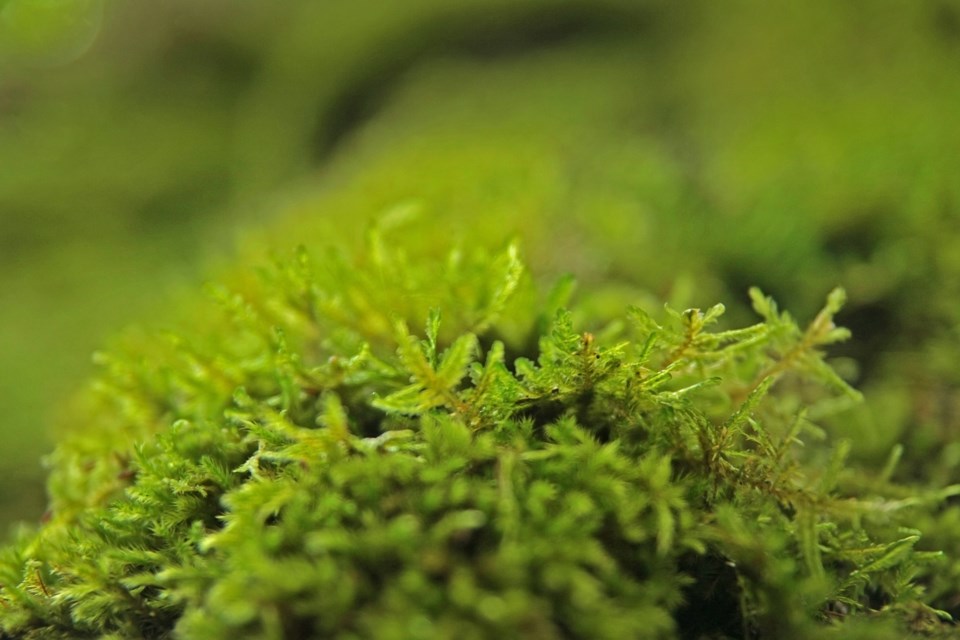The following column was submitted to the Tri-City News from Brian Minter — master gardener, best-selling author, Order of Canada recipient and co-owner of Minter Country Garden Store.
Moss, moss and more moss!
It is in lawns everywhere this year, spreading vigorously and choking out those poor lawn grasses.
In spite of all our moss control efforts, it seems to get worse.
The problem with moss is our lack of understanding about why it grows in our lawns.
We knock it back each year, but we never really seem to get rid of it.
So, let's start by looking at why moss grows.
First of all, it thrives in areas of high rainfall and it loves shady locations.
Wet, poorly drained soil is a wonderful place for moss to become established, because the soil is usually acidic.
In addition to these conditions, moss does very well in soil that has low fertility. Shaded, heavy, wet, acidic soil with low fertility — those are the ideal conditions for moss to grow and spread rapidly.
To control moss we must rectify these conditions, so let's start with the heavy soil.
Light, sandy soils are usually less prone to moss than heavy soils, where water drains away slowly.
One of the first things we must do is improve the porosity and drainage of our soils. Short of plowing our lawns under for a re-do, aeration is the most sensible way to go. You can do this by using a three or five prong hand aerator and pulling out cores of soil throughout your lawn. This is easier than you might think and goes quite quickly.
For larger areas, a commercial aerator would be ideal, but be careful of the roto-tiller types which basically chew up the turf and loosen your teeth at the same time. How you get those cores of heavy soil out of your lawn is up to you, but once that is done, broadcast a 1/4 inch layer of coarse, washed sand over the aerated areas to fill up those holes.
Washed sand is usually cleaner with less weeds. The sharp sand will eat its way down and, in time, help to greatly improve the drainage. You can aerate now, and repeat the process several times a year until you see an improvement in the drainage.
This is one of the secrets of so many great golf courses.
Once you have worked on the drainage, it is important to raise the pH levels of the soil, or in other words, make your soil less acidic. Lime will do that. Prilled limes, meaning they are in an easy-to-apply granular form, are the way to go.
Dolopril lime is one of the best limes available today. It’s granular for easy application, weighs less by about a half, has twice the coverage, works quickly and lasts a long time. Dolopril lime should be applied at 10 kilograms per 200 square meters or 2000 square feet. When you raise the pH level of the soil, grass will grow better.
It’s always best to lime in the fall, but now is also a great time to do it.
Incidentally, the only way to be sure you need lime is to have your soil tested to determine its pH level. There are pH testing kits available at garden centres, but after our wet winter and with the copious quantities of moss in our lawns, I am sure you will be safe applying it.
Once you have increased the pH level, it is time to get rid of the moss. Ferrous ammonium sulphate is the best way of doing that. It comes in a liquid or granular form and will cover approximately 2,000–4,000 sq. ft. of lawn area (refer to package instructions for application rates). Moisten the moss first, apply the moss control dry and arrange to have two dry days afterward when the temperature remains above 10C.
Good luck on that one! Seriously though, that is what is required for successful moss control.
Once you have been able to eliminate the moss, you must rake out all the old dead stuff and apply a nutrient to encourage the remaining grass to get growing and fill in those bare spots before weeds do. A slow-release, high nitrogen fertilizer will do the job nicely and will be soil friendly. For those who wish to stay organic, there is a small selection of organic lawn fertilizers now available.
Your lawn will be in good shape as long as you can eradicate the moss everywhere — from your trees, roof and under your rhododendrons.
Don't forget: moss spreads by spores, so a thorough clean-up is important. All this sounds like a lot of work, but it is not really, especially if you lessen the problem each year by improving the drainage and maintaining more consistent levels of nutrients in your lawn.
The average-sized lawn provides enough oxygen to keep a family of four alive and well. It also collects pollution, helps sequester carbon and, in urban areas, helps minimize heat islands.
If you over-seed with white Dutch clover or micro clover, your lawn will be far more self-sustaining and will provide a home for beneficial insects too.





